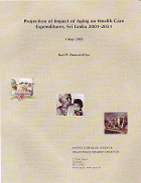Sri Lanka has one of the fastest aging populations in the world. This study develops an actuarial cost projection model to forecast future health spending.
Abstract
We describe the structure and the distribution of healthcare financing in 13 territories that account for 55% of the Asian population. Survey data on household payments are combined with Health Accounts data on aggregate expenditures by source to estimate distributions of total health financing. In all territories, high-income households contribute more than low-income households to the financing of health care. In general, the better off contribute more as a proportion of ability to pay in low and lower-middle-income territories. The disproportionality is in the opposite direction in three high/middle-income territories operating universal social insurance. Direct taxation is the most progressive source of finance and is most progressive in poorer economies with a narrow tax base. The distribution of out-of-pocket (OOP) payments also depends on the level of development. In high-income economies with widespread insurance coverage, OOP payments absorb a larger fraction of the resources of low-income households. In poor economies, they should spend relatively more OOP. This contradicts much of the literature and suggests the poor simply cannot afford to pay for health care in low-income economies. Among the high-income territories, Hong Kong is the one example of progressive financing arising from reliance on taxation, as opposed to social insurance, and an ability to shield those on low incomes from OOP payments. Thailand has a similar financing structure and achieves a similar distributional outcome. The equity implications of a given distribution of financing depend on the extent to which the financing structure ties healthcare use to payments.
Content
1. Global Experience
2. Sri Lanka
3. Changes in Age Structure
4. Sri Lanka Project Model
5. Model Methodology
6. Age-sex variation
7. Age-specific changes
8. Public sector productivity
9. Model Structure
10. Model Results
11. Conclusion

